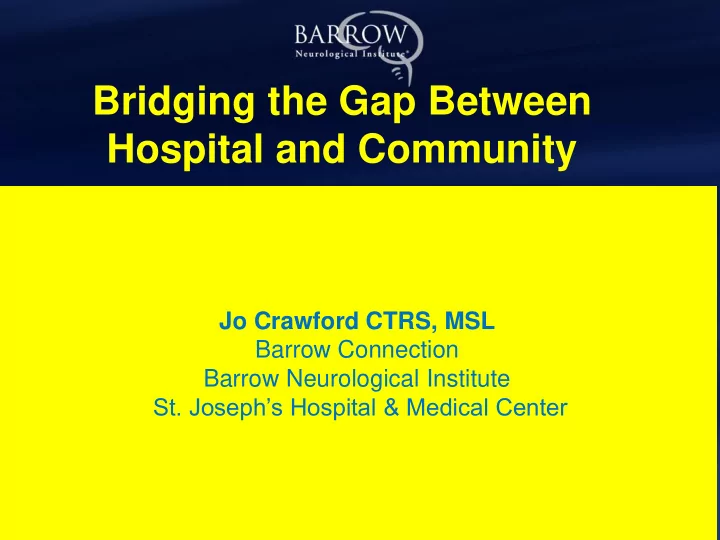

Bridging the Gap Between Hospital and Community Jo Crawford CTRS, MSL Barrow Connection Barrow Neurological Institute St. Joseph’s Hospital & Medical Center
Challenges in rehabilitation Decreased length of stay Adjustment to injury Adjustment to body image Education of family/friends Decreased access to the community while on rehab Decreased absorption of resources
Consequences of a Non-Active Lifestyle In drug/alcohol abuse In secondary conditions In obesity In unemployment
Barriers to Participation Organized activity Cost Equipment Access Trained staff
The Barrow Connection-what we do Navigational tools needed for an active lifestyle Educate the hospital and community Membership is free Meet our Connectors
What does it take to be a Barrow Connector? • Must be 1 year post injury • Interview process • Referred by Physiatrist or therapy team • Complete 8 hour training • Be active and needs to have adjusted to injury
How do I get connected to a Barrow Connector? • Referral from treatment team via Cerner: – neuro-rehab – outpatient – acute setting • Try to match the patient to the mentor with similarities via Smartsheet data base.
Barrow Connectors-Positive mentors
Barrow Connectors- SCI Membership card Connector reaches out to new member Provide resources and encouragement
Barrow Connectors-Brain Injured Survivors Family involvement Complete a mentor training program Contract agreement with BC/hospital
Red Cap
Community Support & Partners • Arizona Disabled Sports • Ability 360 Sports and Fitness Center • Ability 360 Independent Living Center • Municipal Programs • Daring Adventures • Other Rehab Hospitals in Arizona • Valley-wide Community Agencies
Barrow Connection – lets have some fun!
Benefits to the BC Member In medical stay In secondary conditions In drug/alcohol abuse In obesity
Benefits to the BC Member Communication of resources across the continuum of care Collaboration with valley-wide agencies Barrow Connectors-provide support & resources
Dignity Health Grants Community Care of Network Project Independence and Empowerment PIE
Dignity Health Grants Community Funding 2013: $ 88,000 2014: $ 75,000 2015: $ 75,000 2016: $ 56,000 2017/18: $100,000 — BNF Total- $394,000 •
The PIE Community »Ability 360 Sports and Fitness Center »Arizona Spinal Cord Injury Association »Brain Injury Alliance of Arizona
Did You Target Population Know…. In Arizona 24,000 people have a spinal cord injury, and that number increases by • The target population- adults with 250 yearly; over 100,000 have some disabilities of all ethnic and cultural form of paralysis. backgrounds. (Christopher and Dana Reeve Foundation) Each year, over • Served on a cross-disability basis; the 52,000 people in Arizona sustain a majority of people served have physical Traumatic Brain Injury. and/or neurological disabilities. (AZ Department of Health)
PIE Goals 1. Decrease or prevent incidence of secondary conditions 2. Reduce inpatient admissions and ER visits 3. Enhance Quality of Life through health, fitness & nutrition; education/activities; socialization opportunities; peer support; & Community Transition resources 4. Identify system changes for our service delivery model to encourage a seamless family care transition with SJHMC 5. Conduct outreach /offer care transition to extended care facilities
Hospital Navigator Neuro Rehabilitation Continuum Acute > rehab> outpatient > Center for Transitional Neuro Rehabilitation ED Muhammad Ali Parkinson Center Barrow Cranial Facial Center All Neuro Programs
PIE Outcomes ABILITY 360 Sports and Fitness Center • Currently 126 participants and 143 family members are enrolled • Participants complete a pre-enrollment survey, with a follow-up assessment at 3-month intervals. Fitness Transition Results • Weight loss • Reduction of BMI • Gait improvement • Community Involvement
PIE Outcomes Transportation Bus and/or light rail passes have been provided to PIE participants who need transportation. Wheelchair Skills Classes covered topics include: traveling with your chair, transferring, managing your environment and mechanics of your chair. Empowerment Curriculum Classes A 12 week Empowerment Series. Topics included: prevention of secondary conditions after SCI, psycho-social aspects of SCI, medical conditions after SCI, bladder and bowel management, sexuality and SCI, pain management and aging with SCI.
PIE Outcomes Educational Programs Healthy Living Group - Nutrition, Music Therapy, Chronic Pain Management Healthy Living Summer Series Online Educational Sessions Conferences Services Resource Facilitation Brain Gym, 2x/month
Barrow Connection Programs- Driving to Excel Accident Avoidance Exercises Skid Control
Barrow Connection Programs- Driving to Excel • Introduction to Timed Driving • Drive Safer with hand controls HAVE FUN!!! •
Day on the Lake-21 years! • 223 participants • 156 volunteers • Waterskiing • Wakeboarding • Surfing • Tubing • Jet skiing • Fishing • Boat rides • Kayaking • Research
•
surfing
Talk about focus!
Everyone has the right to play!
Everyone has the right to play!
Everyone has the right to risk!
The REAL impact of access! “It got me out of my shell and away from the TV!” Marc Askinazi “It is so empowering!” Madilyn Stanton
Recommend
More recommend